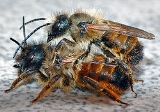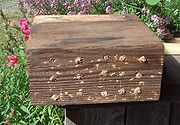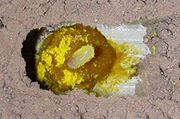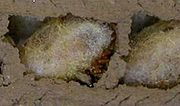
Mason bee
Encyclopedia
Mason bee is a common name for species of bee
s in the genus Osmia, of the family Megachilidae
. They are named from their habit of making compartments of mud in their nests, which are made in hollow reeds or holes in wood made by wood boring insects.
Species of the genus include the orchard mason bee, Osmia lignaria, the blueberry bee, O. ribifloris
, and the hornfaced bee, O. cornifrons. The former two are native to the Americas
and the latter to Japan
, although O. lignaria and O. cornifrons have been moved from their native ranges for commercial purposes. The Red mason bee, Osmia rufa
, is found across the European continent. There are over 300 species across the Northern Hemisphere, and more than 130 species of mason bees in North America; most occur in the temperate regions, and are active from spring through late summer.
Osmia species are usually metallic green or blue, though many are blackish. Most have black ventral scopae which are difficult to notice unless laden with pollen. They have arolia between their claws unlike Megachile
or Anthidium
species.



 Unlike honey bees (Apis) or bumblebee
Unlike honey bees (Apis) or bumblebee
s, Osmia are solitary; every female is fertile and makes her own nest, and there are no worker bees for these species. Solitary bees produce neither honey nor beeswax. They are immune from acarine and Varroa
mites, but have their own unique parasites, pests and diseases.
The bees emerge from their cocoons in the spring, with males the first to come out. They remain near the nests waiting for the females. When the females emerge, the first thing they do is mate. The males die and the females begin provisioning their nests.
Osmia females like to nest in narrow holes or tubes, typically naturally occurring tubular cavities. Most commonly this means hollow twigs, but sometimes abandoned nests of wood-boring beetles or carpenter bee
s, or even snail
shells. They do not excavate their own nests. The material used for the cell can be clay or chewed plant tissue. The palearctic
species O. avosetta
is one of a few species known for lining the nest burrows with flower petals. A female might inspect several potential nests before settling in.
Females then visit flowers to gather pollen and nectar, and it will take many trips to complete a pollen/nectar provision mass. Once a provision mass is complete, the bee backs into the hole and lays an egg on top of the mass. Then she creates a partition of "mud", which doubles as the back of the next cell. The process continues until she has filled the cavity. Female-destined eggs are laid in the back of the nest, and male eggs towards the front.
Once a bee has finished with a nest, she plugs the entrance to the tube, and then may seek out another nest location.
By the summer, the larva has consumed all of its provisions and begins spinning a cocoon around itself and enters the pupa
l stage, and the adult matures either in the fall or winter, hibernating inside its insulatory cocoon. Most Osmia species are found in places where the temperature drops below 0°C for long durations, like Canada
, and they are well-adapted to cold winters.
for early spring fruit flowers. They are used sometimes as an alternative, but more often as an augmentation for European honey bees.
Most mason bees live in holes and are readily attracted to nesting holes; reeds, paper tubes, or nesting trays. Drilled blocks of wood are an option, but do not allow you to harvest the bees, which is vital to control a build up of pests. Blue orchard and hornfaced bees are spring season pollinator
s and will only sting if squeezed or stepped on. As such, they are beneficial and benign, since they both pollinate the plants and are safe for children and pets.
Bee
Bees are flying insects closely related to wasps and ants, and are known for their role in pollination and for producing honey and beeswax. Bees are a monophyletic lineage within the superfamily Apoidea, presently classified by the unranked taxon name Anthophila...
s in the genus Osmia, of the family Megachilidae
Megachilidae
The Megachilidae are a cosmopolitan family of solitary bees whose pollen-carrying structure is restricted to the ventral surface of the abdomen...
. They are named from their habit of making compartments of mud in their nests, which are made in hollow reeds or holes in wood made by wood boring insects.
Species of the genus include the orchard mason bee, Osmia lignaria, the blueberry bee, O. ribifloris
Osmia ribifloris
Osmia ribifloris, one of several species referred to as a blueberry bee, is a megachilid bee native to the coastal mountains of southern California. This solitary bee normally gathers pollen from manzanita, but will pollinate blueberries, and is sometimes used commercially for this purpose....
, and the hornfaced bee, O. cornifrons. The former two are native to the Americas
Americas
The Americas, or America , are lands in the Western hemisphere, also known as the New World. In English, the plural form the Americas is often used to refer to the landmasses of North America and South America with their associated islands and regions, while the singular form America is primarily...
and the latter to Japan
Japan
Japan is an island nation in East Asia. Located in the Pacific Ocean, it lies to the east of the Sea of Japan, China, North Korea, South Korea and Russia, stretching from the Sea of Okhotsk in the north to the East China Sea and Taiwan in the south...
, although O. lignaria and O. cornifrons have been moved from their native ranges for commercial purposes. The Red mason bee, Osmia rufa
Osmia rufa
Osmia rufa is a species of solitary bee, also known as the red mason bee due to its habit of using mud to build small cavities within its nest....
, is found across the European continent. There are over 300 species across the Northern Hemisphere, and more than 130 species of mason bees in North America; most occur in the temperate regions, and are active from spring through late summer.
Osmia species are usually metallic green or blue, though many are blackish. Most have black ventral scopae which are difficult to notice unless laden with pollen. They have arolia between their claws unlike Megachile
Megachile
The genus Megachile is a cosmopolitan group of solitary bees, often called leafcutter bees. While other genera within the family Megachilidae may chew leaves or petals into fragments to build their nests, certain species within Megachile neatly cut pieces of leaves or petals, hence their common name...
or Anthidium
Anthidium
Anthidium is a genus of bees often called mason or potter bees, who use conifer resin, plant hairs, mud, or a mix of them to build nests. They are in the family Megachilidae which is cosmopolitan in distribution and made up of species that are mostly solitary bees with pollen-carrying scopea that...
species.
Life cycle




Bumblebee
A bumble bee is any member of the bee genus Bombus, in the family Apidae. There are over 250 known species, existing primarily in the Northern Hemisphere although they are common in New Zealand and in the Australian state of Tasmania.Bumble bees are social insects that are characterised by black...
s, Osmia are solitary; every female is fertile and makes her own nest, and there are no worker bees for these species. Solitary bees produce neither honey nor beeswax. They are immune from acarine and Varroa
Varroa
Varroa is a genus of parasitic mites associated with honey bees, placed in its own family, Varroidae. The genus was named for Marcus Terentius Varro, a Roman scholar who was also a beekeeper.-History and behavior:...
mites, but have their own unique parasites, pests and diseases.
The bees emerge from their cocoons in the spring, with males the first to come out. They remain near the nests waiting for the females. When the females emerge, the first thing they do is mate. The males die and the females begin provisioning their nests.
Osmia females like to nest in narrow holes or tubes, typically naturally occurring tubular cavities. Most commonly this means hollow twigs, but sometimes abandoned nests of wood-boring beetles or carpenter bee
Carpenter bee
Carpenter bees are large, hairy bees distributed worldwide. There are some 500 species of carpenter bee in 31 subgenera...
s, or even snail
Snail
Snail is a common name applied to most of the members of the molluscan class Gastropoda that have coiled shells in the adult stage. When the word is used in its most general sense, it includes sea snails, land snails and freshwater snails. The word snail without any qualifier is however more often...
shells. They do not excavate their own nests. The material used for the cell can be clay or chewed plant tissue. The palearctic
Palearctic
The Palearctic or Palaearctic is one of the eight ecozones dividing the Earth's surface.Physically, the Palearctic is the largest ecozone...
species O. avosetta
Osmia avosetta
Osmia avosetta is a species of mason bee. It is solitary by nature, and is unique in its use of flower petals to construct nests for its larvae....
is one of a few species known for lining the nest burrows with flower petals. A female might inspect several potential nests before settling in.
Females then visit flowers to gather pollen and nectar, and it will take many trips to complete a pollen/nectar provision mass. Once a provision mass is complete, the bee backs into the hole and lays an egg on top of the mass. Then she creates a partition of "mud", which doubles as the back of the next cell. The process continues until she has filled the cavity. Female-destined eggs are laid in the back of the nest, and male eggs towards the front.
Once a bee has finished with a nest, she plugs the entrance to the tube, and then may seek out another nest location.
By the summer, the larva has consumed all of its provisions and begins spinning a cocoon around itself and enters the pupa
Pupa
A pupa is the life stage of some insects undergoing transformation. The pupal stage is found only in holometabolous insects, those that undergo a complete metamorphosis, going through four life stages; embryo, larva, pupa and imago...
l stage, and the adult matures either in the fall or winter, hibernating inside its insulatory cocoon. Most Osmia species are found in places where the temperature drops below 0°C for long durations, like Canada
Canada
Canada is a North American country consisting of ten provinces and three territories. Located in the northern part of the continent, it extends from the Atlantic Ocean in the east to the Pacific Ocean in the west, and northward into the Arctic Ocean...
, and they are well-adapted to cold winters.
Management
Spring mason bees (blue orchard and hornfaced) are increasingly cultivated to improve pollinationPollination management
Pollination Management is the label for horticultural practices that accomplish or enhance pollination of a crop, to improve yield or quality, by understanding of the particular crop's pollination needs, and by knowledgeable management of pollenizers, pollinators, and pollination...
for early spring fruit flowers. They are used sometimes as an alternative, but more often as an augmentation for European honey bees.
Most mason bees live in holes and are readily attracted to nesting holes; reeds, paper tubes, or nesting trays. Drilled blocks of wood are an option, but do not allow you to harvest the bees, which is vital to control a build up of pests. Blue orchard and hornfaced bees are spring season pollinator
Pollinator
A pollinator is the biotic agent that moves pollen from the male anthers of a flower to the female stigma of a flower to accomplish fertilization or syngamy of the female gamete in the ovule of the flower by the male gamete from the pollen grain...
s and will only sting if squeezed or stepped on. As such, they are beneficial and benign, since they both pollinate the plants and are safe for children and pets.
External links
- Osmia Identification Guide (female)
- Osmia Identification Guide (male)
- List of Species
- Worldwide Species Map
- Palaearctic Osmiine Bees
- More information on how best to raise mason bees
- http://en.wikibooks.org/wiki/Beekeeping/Solitary_Bees

